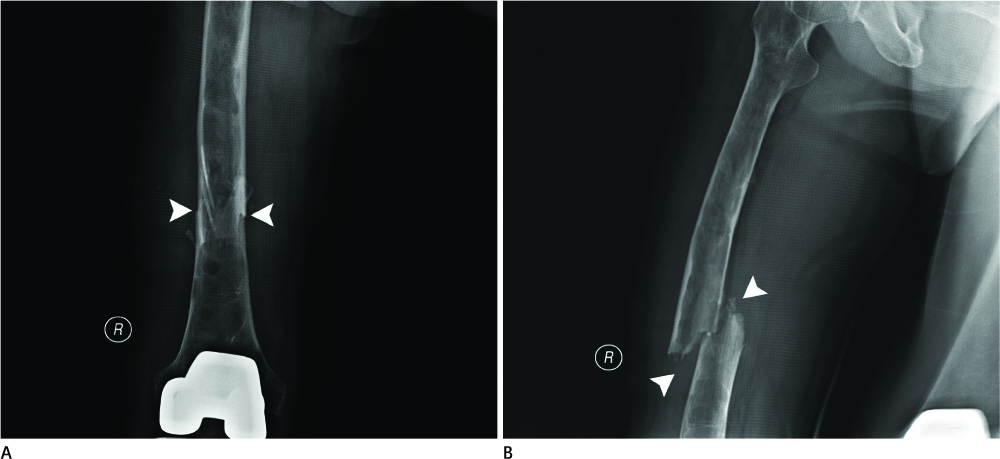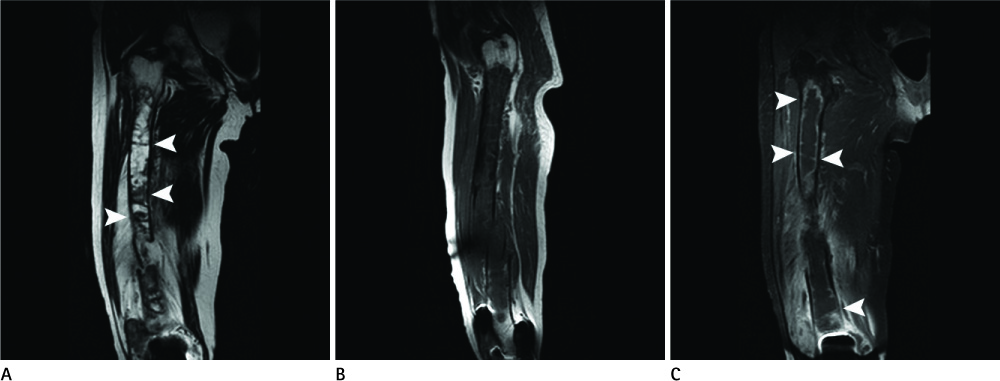J Korean Soc Radiol.
2011 Dec;65(6):607-611. 10.3348/jksr.2011.65.6.607.
Epithelioid Hemangioendothelioma of the Femur with Benign Cystic Appearance
- Affiliations
-
- 1Department of Radiology, Seoul National University Bundang Hospital, Seongnam, Korea. jacrad@radiol.snu.ac.kr
- 2Department of Radiology and Institute of Radiation Medicine, Seoul National University College of Medicine, Seoul, Korea.
- 3Department of Pathology, Seoul National University Bundang Hospital, Seongnam, Korea.
- 4Department of Orthopedic Surgery, Seoul National University Bundang Hospital, Seongnam, Korea.
- KMID: 2002930
- DOI: http://doi.org/10.3348/jksr.2011.65.6.607
Abstract
- An epithelioid hemangioendothelioma is an intermediate grade tumor between hemangioma and angiosarcoma that frequently shows marked enhancement because it is a vascular tumor. Herein, we describe a rare case of a malignant epithelioid hemangioendothelioma of the femur that was mistaken as a benign lesion such as a simple bone cyst or fibrous dysplasia because the tumor had a benign cystic appearance on MRI and its imaging findings showed a histopathologic correlation.
Figure
Reference
-
1. Weiss SW, Enzinger FM. Epithelioid hemangioendothelioma: a vascular tumor often mistaken for a carcinoma. Cancer. 1982; 50:970–981.2. Vigorita VJ, Ghelman B. Vascular/Mesenchymal tumors. Orthopaedic pathology. Philadelphia: Lippincott Williams & Wilkins;1999. p. 399–400.3. Ignacio EA, Palmer KM, Mathur SC, Schwartz AM, Olan WJ. Epithelioid hemangioendothelioma of the lower extremity. Radiographics. 1999; 19:531–537.4. Larochelle O, Périgny M, Lagacé R, Dion N, Giguére C. Best cases from the AFIP: epithelioid hemangioendothelioma of bone. Radiographics. 2006; 26:265–270.5. Murphey MD, Fairbairn KJ, Parman LM, Baxter KG, Parsa MB, Smith WS. From the archives of the AFIP. Musculoskeletal angiomatous lesions: radiologic-pathologic correlation. Radiographics. 1995; 15:893–891.6. Dorfman HD, Czerniak B. Vascular lesions. Bone tumors. Mosby;1998. p. 769–795.7. Kleer CG, Unni KK, McLeod RA. Epithelioid hemangioendothelioma of bone. Am J Surg Pathol. 1996; 20:1301–1311.8. Kabukçuoğlu F, Kabukçuoğlu Y, Livaoğlu A, Ozağari A, Armağan R, Kuzgun U. [Epithelioid hemangioendothelioma of bone]. Acta Orthop Traumatol Turc. 2006; 40:324–328.




